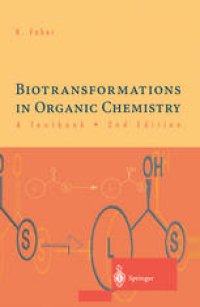
Ebook: Biotransformations in Organic Chemistry — A Textbook
Author: Prof. Dr. Kurt Faber (auth.)
- Tags: Organic Chemistry, Biochemistry general, Biotechnology, Microbiology
- Year: 1995
- Publisher: Springer Berlin Heidelberg
- Language: English
- pdf
The use of biocatalysts, employed either as isolated enzymes or whole cells, offer a remarkable arsenal of highly selective transformations for modern preparative organic chemistry. During the past decade, this methodology has now generally been accepted as a complementary method to the already existing tools. The setup of this first textbook on biocatalysis is based on a professional reference book published in 1992, and it provides a basis for undergraduate and graduate courses in biocatalysis, as well as a condensed introduction into this field for scientists and professionals. After a basic introduction into the use of biocatalysts - principles of stereoselective transformations, kinetics, enzyme nomenclature and -handling, the different types of reactions are explained according to the "reaction principle".
The use of biocatalysts, employed either as isolated enzymes or whole cells, offer a remarkable arsenal of highly selective transformations for modern preparative organic chemistry. During the past decade, this methodology has now generally been accepted as a complementary method to the already existing tools. The setup of this first textbook on biocatalysis is based on a professional reference book published in 1992, and it provides a basis for undergraduate and graduate courses in biocatalysis, as well as a condensed introduction into this field for scientists and professionals. After a basic introduction into the use of biocatalysts - principles of stereoselective transformations, kinetics, enzyme nomenclature and -handling, the different types of reactions are explained according to the "reaction principle".
Content:
Front Matter....Pages I-X
Introduction and Background Information....Pages 1-23
Biocatalytic Applications....Pages 24-269
Special Techniques....Pages 270-340
State of the Art and Outlook....Pages 341-344
Appendix....Pages 345-346
Back Matter....Pages 347-358
The use of biocatalysts, employed either as isolated enzymes or whole cells, offer a remarkable arsenal of highly selective transformations for modern preparative organic chemistry. During the past decade, this methodology has now generally been accepted as a complementary method to the already existing tools. The setup of this first textbook on biocatalysis is based on a professional reference book published in 1992, and it provides a basis for undergraduate and graduate courses in biocatalysis, as well as a condensed introduction into this field for scientists and professionals. After a basic introduction into the use of biocatalysts - principles of stereoselective transformations, kinetics, enzyme nomenclature and -handling, the different types of reactions are explained according to the "reaction principle".
Content:
Front Matter....Pages I-X
Introduction and Background Information....Pages 1-23
Biocatalytic Applications....Pages 24-269
Special Techniques....Pages 270-340
State of the Art and Outlook....Pages 341-344
Appendix....Pages 345-346
Back Matter....Pages 347-358
....
The use of biocatalysts, employed either as isolated enzymes or whole cells, offer a remarkable arsenal of highly selective transformations for modern preparative organic chemistry. During the past decade, this methodology has now generally been accepted as a complementary method to the already existing tools. The setup of this first textbook on biocatalysis is based on a professional reference book published in 1992, and it provides a basis for undergraduate and graduate courses in biocatalysis, as well as a condensed introduction into this field for scientists and professionals. After a basic introduction into the use of biocatalysts - principles of stereoselective transformations, kinetics, enzyme nomenclature and -handling, the different types of reactions are explained according to the "reaction principle".
Content:
Front Matter....Pages I-X
Introduction and Background Information....Pages 1-23
Biocatalytic Applications....Pages 24-269
Special Techniques....Pages 270-340
State of the Art and Outlook....Pages 341-344
Appendix....Pages 345-346
Back Matter....Pages 347-358
The use of biocatalysts, employed either as isolated enzymes or whole cells, offer a remarkable arsenal of highly selective transformations for modern preparative organic chemistry. During the past decade, this methodology has now generally been accepted as a complementary method to the already existing tools. The setup of this first textbook on biocatalysis is based on a professional reference book published in 1992, and it provides a basis for undergraduate and graduate courses in biocatalysis, as well as a condensed introduction into this field for scientists and professionals. After a basic introduction into the use of biocatalysts - principles of stereoselective transformations, kinetics, enzyme nomenclature and -handling, the different types of reactions are explained according to the "reaction principle".
Content:
Front Matter....Pages I-X
Introduction and Background Information....Pages 1-23
Biocatalytic Applications....Pages 24-269
Special Techniques....Pages 270-340
State of the Art and Outlook....Pages 341-344
Appendix....Pages 345-346
Back Matter....Pages 347-358
....
Download the book Biotransformations in Organic Chemistry — A Textbook for free or read online
Continue reading on any device:

Last viewed books
Related books
{related-news}
Comments (0)